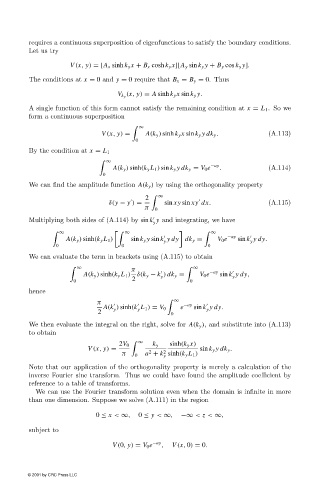Page 500 - Electromagnetics
P. 500
requires a continuous superposition of eigenfunctions to satisfy the boundary conditions.
Let us try
V (x, y) = [A x sinh k y x + B x cosh k y x][A y sin k y y + B y cos k y y].
The conditions at x = 0 and y = 0 require that B x = B y = 0.Thus
(x, y) = A sinh k y x sin k y y.
V k y
A single function of this form cannot satisfy the remaining condition at x = L 1 .So we
form a continuous superposition
∞
V (x, y) = A(k y ) sinh k y x sin k y ydk y . (A.113)
0
By the condition at x = L 1
∞
A(k y ) sinh(k y L 1 ) sin k y ydk y = V 0 e −ay . (A.114)
0
We can find the amplitude function A(k y ) by using the orthogonality property
2 ∞
δ(y − y ) = sin xy sin xy dx. (A.115)
π 0
Multiplying both sides of (A.114) by sin k y and integrating, we have
y
∞ ∞ ∞
A(k y ) sinh(k y L 1 ) sin k y y sin k ydy dk y = V 0 e −ay sin k ydy.
y y
0 0 0
We can evaluate the term in brackets using (A.115) to obtain
∞ ∞
π
−ay
A(k y ) sinh(k y L 1 ) δ(k y − k ) dk y = V 0 e sin k ydy,
y
y
0 2 0
hence
π ∞
−ay
A(k ) sinh(k L 1 ) = V 0 e sin k ydy.
y
y
y
2 0
We then evaluate the integral on the right, solve for A(k y ), and substitute into (A.113)
to obtain
∞
2V 0 k y sinh(k y x)
V (x, y) = sin k y ydk y .
2
2
π 0 a + k sinh(k y L 1 )
y
Note that our application of the orthogonality property is merely a calculation of the
inverse Fourier sine transform. Thus we could have found the amplitude coefficient by
reference to a table of transforms.
We can use the Fourier transform solution even when the domain is infinite in more
than one dimension. Suppose we solve (A.111) in the region
0 ≤ x < ∞, 0 ≤ y < ∞, −∞ < z < ∞,
subject to
V (0, y) = V 0 e −ay , V (x, 0) = 0.
© 2001 by CRC Press LLC

